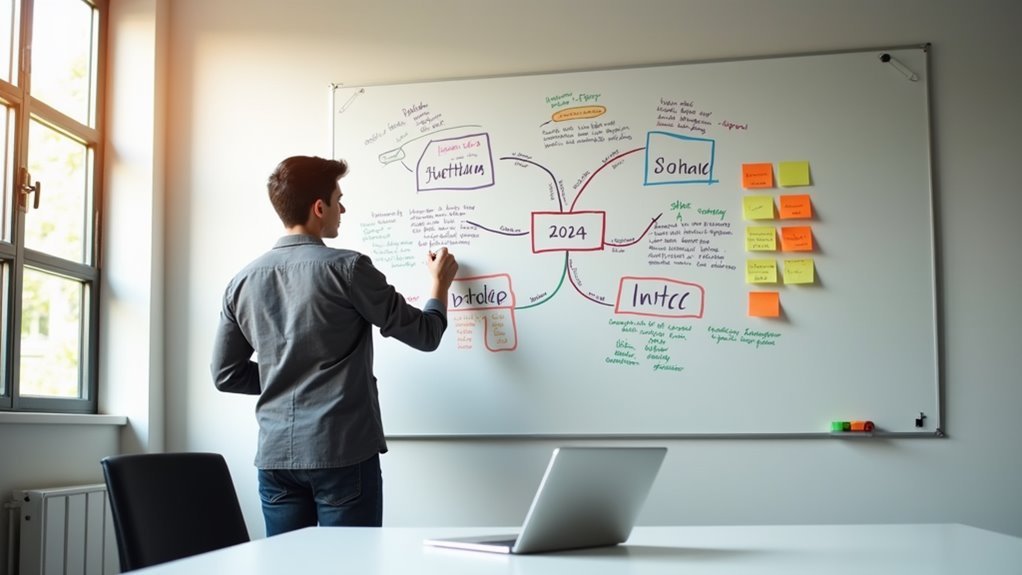We've all heard the saying "leaders are born, not made," but that's not entirely true. While some may have natural leadership abilities, we can all develop and refine our leadership skills through intentional effort and strategic planning. Today's competitive landscape demands that we take control of our professional growth rather than leaving it to chance. Let's explore how creating a personal leadership development plan can transform our potential into tangible success, starting with understanding what true leadership means and how we can systematically build the skills we need.
Understanding Personal Leadership
Personal leadership's foundation rests on our ability to guide ourselves before we can lead others. It's about developing a leadership mindset that emphasizes both direction and self-improvement. When we set clear goals and break them into manageable tasks, we create a pathway to success that aligns with our personal integrity and vision.
We must acknowledge that understanding our strengths and weaknesses forms the cornerstone of effective personal leadership. Through continuous learning and self-reflection, we can identify areas for growth while building upon our existing capabilities. Developing proactive behavior patterns drives progress toward our objectives.
Taking calculated risks and maintaining self-discipline helps us evolve and adapt to new challenges.
The journey of personal leadership requires us to embrace core characteristics that define successful leaders. We need courage to take bold actions, respect to build meaningful relationships, and resilience to overcome obstacles.
Our self-awareness helps us recognize when we're on track and when we need to adjust our approach. By focusing on these elements, we're not just improving ourselves – we're creating a foundation for broader impact in our careers, relationships, and communities.
Assess Your Current Skills

Taking stock of our leadership capabilities begins with a thorough self-assessment using proven tools and techniques.
A systematic evaluation helps leaders to gain enhanced credibility and build trust with their teams.
Through skill gap analysis and structured self-reflection techniques, we can identify our strengths and areas needing improvement. Let's utilize established assessment tools like the DISC Profile and ESCI to gain deeper insights into our behavioral styles and emotional competencies.
We'll want to implement multiple approaches for an exhaustive evaluation. Reflective journaling helps us document and learn from our daily leadership experiences, while the STAR method allows us to analyze specific situations and their outcomes.
Regular use of checklists and surveys provides measurable benchmarks for our progress.
Define Your Leadership Vision

With our skills assessment complete, we can now focus on creating a powerful leadership vision that will shape our future impact.
Our vision statement serves as the compass that guides our journey and inspires others to follow. It's not just about where we want to go; it's about the leadership legacy we want to leave behind and the lasting difference we aim to make. A clear vision provides direction and motivation even during the most challenging periods.
To craft a compelling vision that resonates with our teams and aligns with our values, let's focus on these essential elements:
- Start by clearly articulating our desired future state using specific, measurable language that begins with "Our vision is to…"
- Include core values and themes that reflect our authentic leadership style and beliefs
- Define the impact we want to have on our team, organization, and broader community
- End with a strong call to action that motivates and energizes our followers
Set Clear Development Goals

Once we've established our leadership vision, setting clear development goals becomes the essential next step in turning aspirations into reality. By following the SMART framework, we're guaranteeing our goals are specific, measurable, achievable, relevant, and time-bound, creating a solid foundation for success. This approach ensures that our goals provide direction and motivation, which are key to career success.
Goal alignment with our organization's strategic objectives is vital. We'll want to engage stakeholders in our goal-setting process to gain valuable insights and guarantee our development plans serve both individual and organizational needs. Resource utilization and proper documentation through project management software helps maintain organized tracking of development goals.
Through stakeholder engagement, we can better understand expectations and create more impactful goals. Breaking down our objectives into manageable milestones helps us track progress effectively. Let's focus on key areas like talent development, leadership skills enhancement, and professional networking.
For instance, we might set goals to attend specific industry events, establish mentorship relationships, or develop particular competencies like active listening and emotional intelligence. Ensuring these goals are aligned with professional growth areas such as skill enhancement will enhance job competency and career advancement.
Remember to document progress, gather feedback regularly, and adjust goals as needed. By maintaining clear metrics and action plans, we're better positioned to evaluate our development and make necessary course corrections along our leadership journey.
Choose Growth Opportunities

Successful leaders map out concrete growth opportunities that align with their development goals and current skill gaps.
We can identify and pursue opportunities that enhance our leadership capabilities through a combination of structured learning and practical experiences. By carefully selecting activities that target our specific development needs, we'll create a more focused and effective path to leadership excellence. Regular evaluations help determine if our chosen opportunities are delivering the intended results.
Let's zero in on proven growth opportunities that yield measurable results:
- External Courses and workshops that provide structured learning environments, allowing us to gain new perspectives and acquire specific leadership skills from experienced instructors
- Mentorship Programs that connect us with seasoned leaders who can share their insights, provide guidance, and help us navigate leadership challenges
- Workplace projects and initiatives that offer hands-on experience in leading teams, making decisions, and managing resources
- Professional networking events and conferences where we can learn from industry leaders, exchange ideas, and build valuable connections
Track Progress and Adjust

Having identified our growth opportunities, we must now monitor our development journey and make timely adjustments to stay on course. Let's establish clear progress metrics through specific KPIs and OKRs that align with our leadership goals.
We'll track vital measurements like employee engagement, retention rates, and 360-degree feedback to gauge our effectiveness. Utilizing specialized project management tools like Trello helps organize and visualize our progress effectively.
Regular evaluation is vital for success. We should collect feedback from multiple sources, including peers, mentors, and team members, to gain thorough insights into our leadership performance.
This feedback helps us identify areas where we're excelling and where we need improvement.
Our adjustment strategies should remain flexible and data-driven. When we notice gaps between our goals and actual performance, we'll make necessary course corrections.
We can modify our development plans based on changing circumstances, new insights, or organizational needs. It's imperative to maintain accountability throughout this process, whether through accountability partners, coaches, or regular self-assessment.
Build Your Support Network

A strong support network forms the foundation of effective leadership development. Building relationships with mentors, peers, and like-minded individuals creates opportunities for growth, feedback, and mutual support. By investing time in authentic connections and remaining open to vulnerability, we create meaningful bonds that enhance both our personal and professional lives. This process also fosters emotional intelligence, which is pivotal for personal growth.
Setting SMART objectives helps us track and measure the success of our networking efforts.
Let's focus on these essential steps to build our support network:
- Join professional organizations and interest groups where we can connect with others who share our goals and aspirations.
- Schedule regular check-ins with mentors and peers to discuss challenges, progress, and receive honest feedback.
- Leverage technology through social media groups and virtual meetings to maintain relationships across distances.
- Offer support and mentorship to others, creating reciprocal relationships that strengthen our network.
Remember that quality matters more than quantity when building relationships. We should focus on creating genuine connections with people who challenge and inspire us.
Frequently Asked Questions
How Do I Maintain Leadership Motivation During Personal or Professional Setbacks?
We maintain leadership drive by developing resilience strategies like reframing challenges as growth opportunities and cultivating an adaptive mindset that views setbacks as temporary obstacles we'll overcome together.
Can Introverted Personalities Become Effective Leaders?
Research shows introverted leaders achieve higher profits with proactive teams. We can leverage introvert strengths like deep listening and quiet influence to become highly effective leaders, making our natural tendencies an advantage.
What Role Does Age Play in Developing Leadership Capabilities?
We develop leadership capabilities throughout our life experience and developmental stages, starting in early childhood and continuing as we age, with maturity enhancing our decision-making and interpersonal effectiveness.
How Do Cultural Differences Impact Personal Leadership Style Development?
We must recognize cultural nuance shapes how we lead and interact with others. Our leadership adaptability grows when we embrace diverse perspectives and adjust our approaches across different cultural contexts.
Should I Change My Leadership Approach When Leading Different Generations?
Like a skilled chameleon, we must adapt our leadership style using generational insights and tailored communication approaches. Let's adjust our methods while maintaining authenticity to effectively connect with each generation's values.
Conclusion
Isn't it empowering to know we're in control of our leadership journey? We've explored the essential elements of creating a personal leadership development plan, from self-assessment to building support networks. By taking charge of our growth, setting clear goals, and staying committed to continuous improvement, we're not just developing leadership skills – we're transforming into the leaders we aspire to be.

